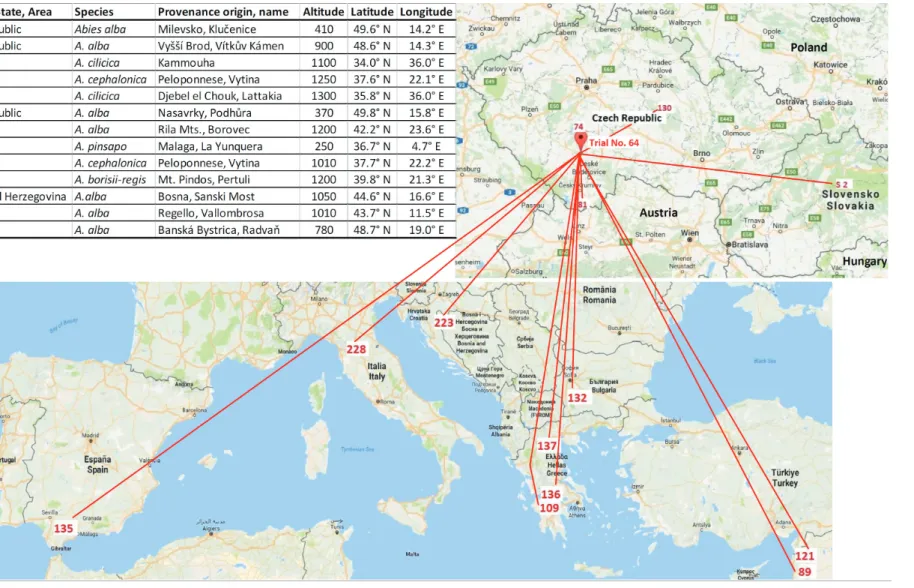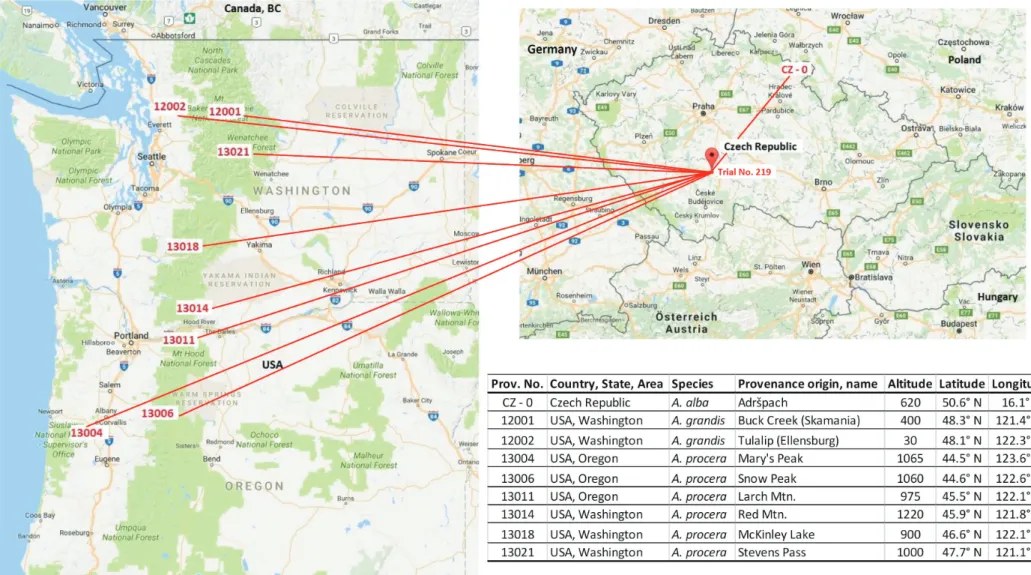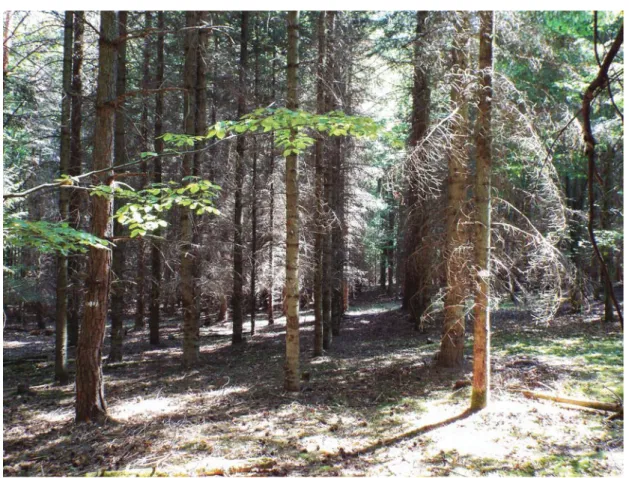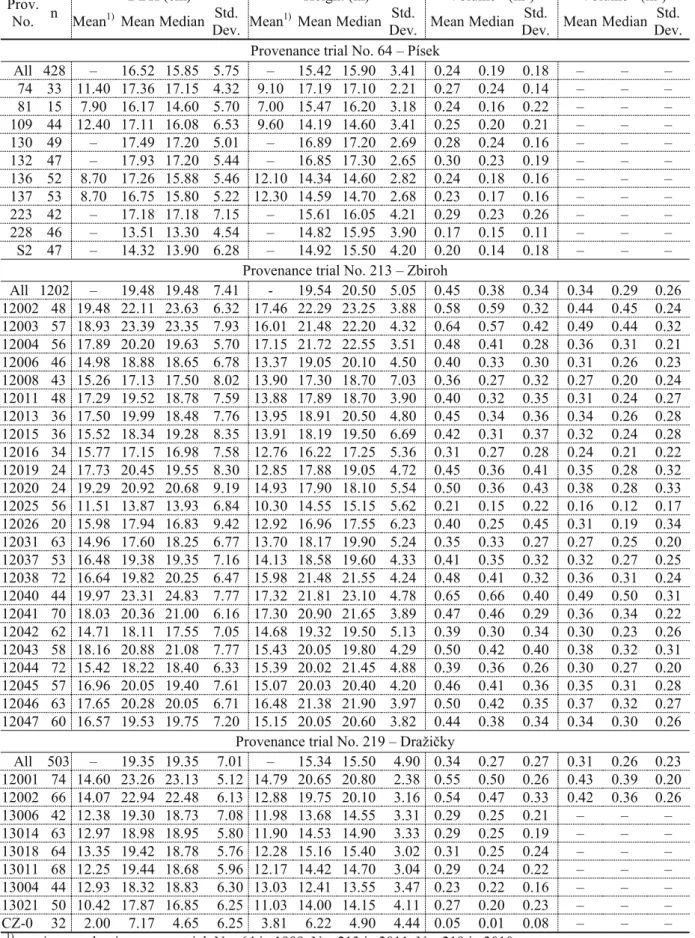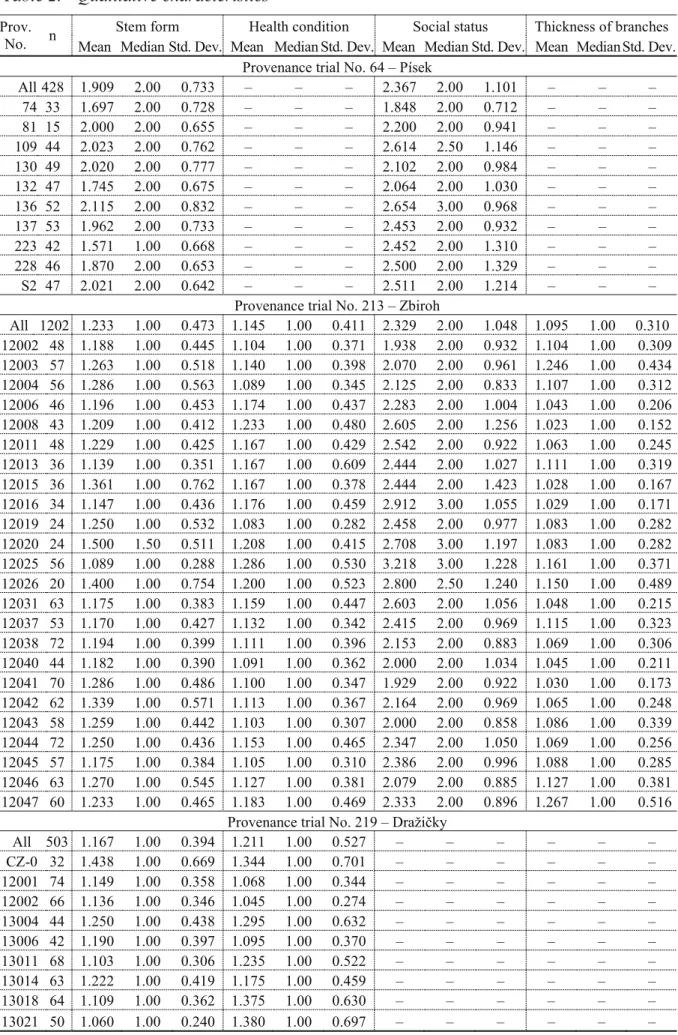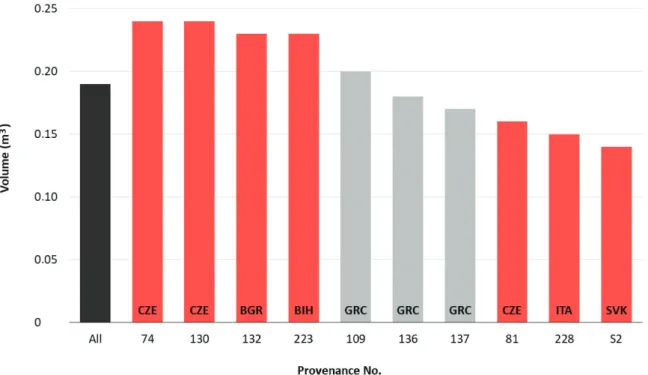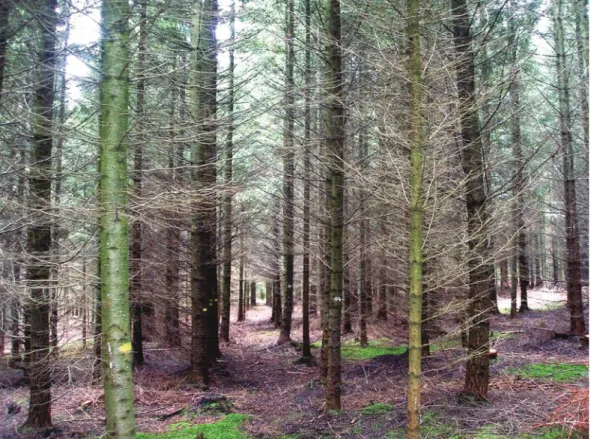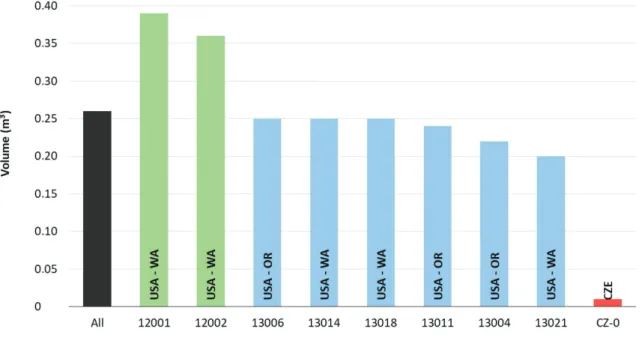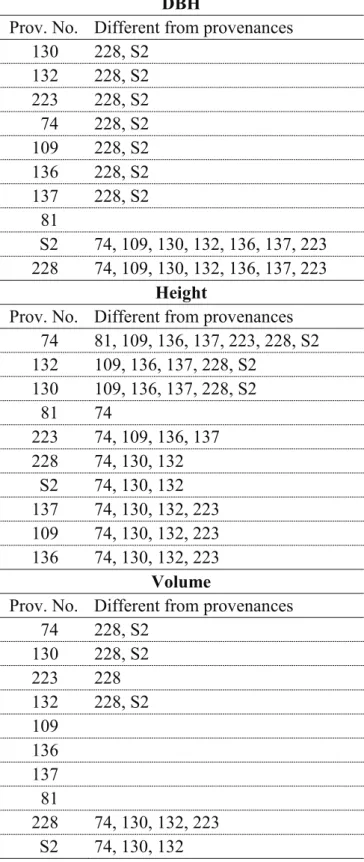Exotic Abies Species in Czech Provenance Trials:
Assessment after Four Decades
Josef F
RÝDLa*– Jaroslav D
OSTÁLa– František B
ERANa– -LĜt ý
ÁPa– Martin F
ULÍNa– John F
RAMPTONb– Gregor B
2ä,ýc– Csaba M
ÁTYÁSdaDepartment of Biology and Forest Tree Breeding, Forestry and Game Management Research Institute, -tORYLãWČCzech Republic
bDepartment of Forestry & Environmental Resources, North Carolina State University, USA
cDepartment of Forest Physiology and Genetics, Slovenian Forestry Institute, Ljubljana, Slovenia
dInstitute of Environmental and Earth Sciences, Faculty of Forestry, University of Sopron, Hungary
Abstract – The growth of seven exotic true fir (Abies) species and native Abies alba have been compared in three provenance trials in the Czech Republic, at the relatively advanced ages of 44, 38, and 35 years respectively. A clear differentiation is observable between the species. The closely related species group of A. alba and A. cephalonica appears rather heterogeneous in its phenotypic behavior. A. alba provenances show superiority, but also a high differentiation. Productivity of provenances of A. cephalonica fall behind A. alba; however A. cilicicaand A. pinsapo provenances have shown total mortality. The high potential of A. grandis is confirmed by outstanding growth;
provenances from the coastal plain in Washington State performed best. A. proceragrows slower than A. grandis, but still faster than A. alba provenances. Health risks, extreme ecologic distances of transfer, trend shifts of growth rate, and rank change with age are uncertainties that require necessary caution when selecting provenances for importation. In recent years, public and institutional perceptions concerning the introduction of non-native tree species and provenances has shifted, and the practice is no longer seen as necessarily inappropriate.
provenance research / assisted migration / Mediterranean firs / Abies grandis / Abies procera
Kivonat – Idegenhonos Abies fajok cseh származási kísérletekben: eredmények négy évtized után.
1\ROFMHJHQ\HIHQ\ĘIDMQ|YHNHGpVpWKDVRQOtWRWWiN|VV]HKiURPNtVpUOHWEHQYLV]RQ\ODJLGĘVLOOHWYH 35 éves korban. A közeli rokon A. alba,A. cephalonicaés A. borisii-regisfajok fenotípusos viselkedése eléggé heterogén. A N|]|QVpJHV MHJHQ\HIHQ\Ę Q|YHNHGpVH D OHJMREE GH HUĘVHQ GLIIHUHQFLiOW $z A.
cephalonicaés A. borisii-regisMHJHQ\HIHQ\ĘV]iUPD]iVRNWHOMHVtWPpQ\HJ\HQJpEEPtJD]A. cilicicaés A.
pinsaposzármazások teljes mortalitást mutattak. A már korábban is behozatalra alkalmasnak ítélt amerikai A. grandis bizonyította kiváló adottságait; a Washington állambeli, parti populációi hozták a legjobb eredményeket. Az A. nobilis ODVV~EE Q|YHNHGpVĦ GH PpJ tJ\ LV PHJKDODGMD D] ĘVKRQRVA. alba-t. A EHKR]DWDOUyO KR]DQGy G|QWpVW PHJHOĘ]Ęóvatosságot indokolják az egészségi állapot kockázatai, extrém
|NROyJLDL HOWpUpVHN D V]iUPD]iVL KHO\V]tQKH] NpSHVW WRYiEEi D WHOMHVtWPpQ\ HVHWOHJHV URPOiVD LGĘVHEE NRUEDQ $] XWyEEL LGĘEHQ D KDWyViJRN pV D Q\LOYiQRVViJ NRUiEEL HOXWDVtWy PDJDWDUWiVD D] LGHgenhonos fajok, populációk behozatalával kapcsolatban enyhülni látszik.
s]iUPD]iVLNtVpUOHWH]pVWiPRJDWRWWPLJUiFLyPHGLWHUUiQMHJHQ\HIHQ\ĘNAbies grandis/Abies procera
10 Frýdl, J. et al.
Acta Silv. Lign. Hung. 14 (1), 2018
1 INTRODUCTION
Silver fir (Abies albaMill.) has been an important component of forest ecosystems in Central Europe. In the course of the last two centuries, however, the species has suffered a considerable decline in mountain ecosystems across the continent, including the Czech Republic. The share of silver fir in Czech forests has shrunk to a small fraction of its original distribution, presently amounting to a reduced area of 28,700 ha, which represents about 1.1%
RIWRWDOIRUHVWDUHD0=Hý5$OWKRXJKWKHUHLVVRPHGLVDJUHHPHQWRYHUWKHUHDVRQV for this decline, it is generally assumed that numerous factors are the cause, though air pollution is regarded as the primary reason. The possible replacement of silver fir with introduced species in forest ecosystems nonetheless raises numerous ecological and silvicultural questions. Although both nature conservationists and the public have condemned the introduction of non-native tree species in the past, institutional and public perception of non-native tree species has shifted towards a more tolerant attitude in recent years. Projected climate change scenarios have likely influenced this perception shift. Introduction (“assisted migration”) of non-invasive foreign species and provenances to improve the resilience and stability of forest ecosystems is no longer regarded as necessarily inappropriate.
Previous research suggests that Douglas fir (Pseudotsuga menziesii (Mirb.) Franco) and grand fir (A. grandis(Douglas ex D. Con) Lindl.) have the best prospects for replacing silver fir in domestic forestry, even for close-to-nature forest management systems (see list of references)1.†However, the introduction of exotic tree species requires further basic research information, particularly the evaluation of comparative trials. The Czech Forestry and Game Management Research Institute (FGMRI) is committed to this task by maintaining national provenance experiments and participating in international co-operations such as IUFRO and COST projects (e.g. Burzynski – 9DQþXUD1985, 9DQþXUD 1990, Beran 2006, Dostál et al.
2016) with the aim of evaluation and testing possibilities for Abiesspp. introduction and their use in forest management of the Czech Republic.
2 MATERIALS AND METHODS
With the aim of comparing the local adaptability and growth of exotic fir species, FGMRI established a national provenance experiment and two IUFRO provenance trials between 1976 and 1984. Besides local and foreign provenances of A. alba(silver fir), provenances of seven exotic fir species were tested: A. cephalonica Loud., Greek fir, native to Greece, mainly from Macedonia to the Peloponnese;A. cilicica (Ant. et Kotschy) Carriere, Cilician or Taurus fir, native to southern Turkey, western Syria and northern Lebanon; A. pinsapo Boiss., Spanish fir, native to southern Spain and northern Morocco; A. borisii-regis Mattf., King Boris or Balkan fir, a hybrid between A. alba and A. cephalonica (Krajmerová et al. 2015), native to southern Albania, Bulgaria and northern Greece; A. grandis (Dougl. ex D. Don) Lindl.), grand fir, native to western North America, distributed along the Pacific coast from southern British Columbia to northwestern California, in the Cascades of Washington and Oregon and in the Rocky Mountains of southern Alberta, western Montana, Idaho and northeast Oregon; and finally A. procera Rehder, noble fir, also native to western North America, distributed mainly in the Cascades of Washington, Oregon and northwestern California.
The origin of provenances included in the trials are listed and presented in Figures 1–3.
Maps were prepared with use of Google Maps web application (https://maps.google.com).
1†A large variety of papers deal with this problem in Czech language. Pertinent publications are included in the list of references
2.1 Provenance trial No. 64, Písek (Figure 1)
This trial is located in Písek municipal forests (49.27° N, 14.33° E) and belongs to the national series of FGMRI 1976. It was established in 1976 on the site of an abandoned forest nursery site in the )RUHVW1DWXUH5HJLRQ&HQWUDO+LOOV6WĜHGRþHVNiYUFKRYLQDRQLWVsouthern border with the Forest Nature Region South Bohemian Basin -LKRþHVNp SiQYHat 395 m above sea level. The average annual temperature is 7.2 °C with an average annual rainfall of 610 mm. The northwest exposure is a mild slope. The soil is of loam-sandy type over granodiorite bedrock. The rectangular-shaped trial covers 0.39 ha.
The test was established in a randomized block design with three repetitions and 13 provenances. Each plot is 10 m × 10 m and contained 50 seedlings (5 rows by 10 plants) at a planting spacing of 2 m × 1 m. A total of 1,950 seedlings were planted at the site. The compared species belong to five European taxa; two silver fir provenances served as native standards. Five-year-old bare-root seedlings were manually planted in the spring of 1976. The trial was fenced in order to prevent game damage. Replanting seedlings that did not survive was impossible because reserve plants were unavailable.
The first juvenile thinning was carried out in 1996. Until then only dead individuals had been removed from the trial at irregular intervals. This first thinning was aimed at reducing the low-grade and dying trees and the material was left onsite. The first regular thinning was carried out in 2005 based on the tree markings provided by research staff. Negative sub-level selection was applied and some of naturally regenerated Abies albatrees were removed, too.
The most recent thinning was carried out in 2014 on crown thinning basis with the aim of preserving the spatial structure and releasing the promising individuals. At the same time, the dead trees were eliminated. All cut trees were removed from the trial.
2.2 Provenance trial No. 213, Zbiroh (Figure 2)
Provenance trial No. 213, Zbiroh is part of the IUFRO international trial series 1977, and was HVWDEOLVKHG LQ QHDU WKH YLOODJH RI 9ROGXFK\ LQ WKH 3O]HĖregion (49.79° N, 13.64° E).
At present, it is owned by Colloredo-Mansfeld Ltd. The trial lies in the Forest Nature Region Brdská Highlands (Brdská vrchovina). The trial lies on a mild slope with southeast exposure with an altitude of 450 to 460 m above sea level. The average annual temperature does not exceed 7 °C, while the average precipitation reaches 600–650 mm. Pedology conditions are characterized by loamy and pseudogley soils on pleistocene clay bedrock (Krejzek et al.
2015).
The provenance trial was established with three-year-old seedlings grown from seed imported from the USA. It consists of two 0.5 ha rectangles, 80 m apart, divided into plots of 10 m × 10 m. A total of 24 provenances of grand fir were planted with 25 seedlings per plot in four repetitions, in 2 m × 2 m spacing. Originally, each provenance was represented by 100 individuals. At the beginning, young seedlings suffered from water logging (especially replications 1 and 3) and partly from frost hollow conditions (Beran 2006).
Frýdl,J. et al.12
Acta Silv. Lign. Hung. 14(1), 2018
Figure 1. Origin of Abies spp. provenances tested in the trial No. 64, Písek
ovenances of exotic Abies species in the Czech Republic
Acta Silv. Lign. Hung. 14(1
Frýdl,J. et al.14
Acta Silv. Lign. Hung. 14(1), 2018
Figure 3. Origin of Abies spp. provenances tested in the WULDO1R'UDåLþN\
2.3 Provenance trial No. 219, 'UDåLþN\(Figure 3)
3URYHQDQFH WULDO 1R 'UDåLþN\ 1 ( LV SDUW RI DQ LQWHUQDWLRQDO provenance experiment launched by IUFRO in the 1980s in the former Czechoslovakia and in 16 other European countries (Burzynski – 9DQþXUD 1985). This trial, presently owned by K.
9RGĖDQVNê ZDV HVWDEOLVKHG in 1984, together with two others of this series, in the Forest 1DWXUH 5HJLRQ &HQWUDO +LOOV 6WĜHGRþHVNi YUFKRYLQD RQ LWVsouthern border with the Forest Nature Region 6RXWK %RKHPLDQ %DVLQ -LKRþHVNp SiQYHat 485 m above sea level. The average annual temperature is 8.5 °C with an average annual rainfall of 560 mm. The topography is plain. The bedrock is South Bohemian crystalline unit (gneiss), the soil is sandy loam.
The area of the rectangular trial is 0.36 ha. A randomized block design was employed with 4 repetitions. The trial contains 6 noble fir provenances and 2 provenances of grand fir, grown from seed imported from the USA. One native silver fir provenance was included as a comparative standard. Each block is 10 m × 10 m with a planting spacing of 2 × 2 m. Four- year-old seedlings were used for planting. Each plot was originally planted with 25 seedlings (5 rows by 5 seedlings). Damaged and dead trees were removed during later thinnings.
2.4 Measurements of trials
All three trials were measured in autumn 2015. The measurement age of the trials in the descriptions refers to age from seed (i.e. including nursery raising). Height and diameter at breast height (DBH) were measured. Volume was calculated using published equations for Abies alba(Petráš– Pajtík 1991) andA. grandis(Rau et al. 2008); the volume of other Abies species was calculated using equations for Abies alba.
The health status of all trees was visually assessed for trials No. 213 and 219 according to the following scale: 1 = excellent, 2 = good (less vigor, no signs of damage), 3 = dying or showing signs of decline (vigor significantly reduced). The survival of provenances was not evaluated because of thinnings executed in all three trials in previous periods. Stem form was evaluated in all three trials according to the following scale: 1 = straight, 2 = curved once, 3 = curved several times. For the canopy position evaluation of trees in trials No. 64 and No. 213, the modified Kraft-Konšel tree classes were used according to the following scale:
1 = pre-dominant, 2 = co-dominant, 3 = sub-dominant or recessive, 4 = overshadowed but vital, 5 = dying or dead tree. In trial No. 213, branch thickness was assessed using the following classification scale: 1 = weak branches, up to about 1/10 of DBH, sparse branching, 2 = thick branches, between 1/10 and 2/10 of DBH, high density of branching, 3 = very thick branches, above 2/10 of DBH, very high density of branching.
2.5 Statistical analysis
Median values, which suppress extreme or distorting values for height, DBH, and volume production, were calculated in addition to simple means. The processing and preparation of data files for statistical analysis were performed according to standard procedures. Statistical calculations were performed using the QC.Expert 3.1 and NCSS 10 (version: 10.0.6) programs. Data and statistics of quantitative and qualitative traits of provenances are summarized in Tables 1 and2. The significance of differences among provenances was tested using the Kruskal-Wallis One-Way ANOVA test due to the non-normality of the data. Results from Kruskal-Wallis multiple-comparison z-value test for traits are presented in the Appendix, Tables 3–5. The one-way ANOVAs for each trait rejected the null hypothesis of HTXDOPHDQYDOXHVDWĮ OHYHO; it is valid for all three trials. Regarding the significance of mean and median differences of provenances, it must be noted that the one-way analysis does not separate error and between-repetition (block) variance; therefore, calculated
16 Frýdl, J. et al.
Acta Silv. Lign. Hung. 14 (1), 2018
significant differences appear larger than in reality. The comparison of data from different measurement dates also indicates the higher reliability provenance ranking than proposed by Kruskal-Wallis statistics. Thus, best and worst performers are listed in the results even if differences appear insignificant.
3 RESULTS
3.1 Trial No. 64, Písek(Figure 4)
Figure 4. Provenance trial No. 64, Písek at the age of 44 years
A total of 428 trees were measured and assessed in 2015 at the age of 44 years. The overall medians for DBH and height were 15.9 cm and 15.9 m, respectively. Two silver fir provenances, one originating from the Czech Republic 1DVDYUN\3RGKĤUDFPDQG another from Bulgaria (No. 132 Borovec, Rila Mts., 17.2 cm) had the largest DBH medians.
The provenances with the smallest DBH medians at this site were silver fir provenances S2 5DGYDĖ%DQVNi%\VWULFD6ORYDNLDFPDQG5HJHOOR9DOORPEURVD,WDO\cm).
The lowest height median occurred in two Greek Abies cephalonica provenances, No. 109 (14.6 m) and No. 136 (14.6 m), both originating from Vytina, Peloponnese.
Table 1. Quantitative characteristics
Prov.
No. n
DBH (cm) Height (m) Volume2)(m3) Volume3)(m3) Mean1) Mean Median Std.
Dev. Mean1) Mean Median Std.
Dev. Mean Median Std.
Dev. Mean Median Std.
Dev.
Provenance trial No. 64 – Písek
All 428 – 16.52 15.85 5.75 – 15.42 15.90 3.41 0.24 0.19 0.18 – – – 74 33 11.40 17.36 17.15 4.32 9.10 17.19 17.10 2.21 0.27 0.24 0.14 – – – 81 15 7.90 16.17 14.60 5.70 7.00 15.47 16.20 3.18 0.24 0.16 0.22 – – – 109 44 12.40 17.11 16.08 6.53 9.60 14.19 14.60 3.41 0.25 0.20 0.21 – – – 130 49 – 17.49 17.20 5.01 – 16.89 17.20 2.69 0.28 0.24 0.16 – – – 132 47 – 17.93 17.20 5.44 – 16.85 17.30 2.65 0.30 0.23 0.19 – – – 136 52 8.70 17.26 15.88 5.46 12.10 14.34 14.60 2.82 0.24 0.18 0.16 – – – 137 53 8.70 16.75 15.80 5.22 12.30 14.59 14.70 2.68 0.23 0.17 0.16 – – – 223 42 – 17.18 17.18 7.15 – 15.61 16.05 4.21 0.29 0.23 0.26 – – – 228 46 – 13.51 13.30 4.54 – 14.82 15.95 3.90 0.17 0.15 0.11 – – – S2 47 – 14.32 13.90 6.28 – 14.92 15.50 4.20 0.20 0.14 0.18 – – –
Provenance trial No. 213 – Zbiroh
All 1202 – 19.48 19.48 7.41 - 19.54 20.50 5.05 0.45 0.38 0.34 0.34 0.29 0.26 12002 48 19.48 22.11 23.63 6.32 17.46 22.29 23.25 3.88 0.58 0.59 0.32 0.44 0.45 0.24 12003 57 18.93 23.39 23.35 7.93 16.01 21.48 22.20 4.32 0.64 0.57 0.42 0.49 0.44 0.32 12004 56 17.89 20.20 19.63 5.70 17.15 21.72 22.55 3.51 0.48 0.41 0.28 0.36 0.31 0.21 12006 46 14.98 18.88 18.65 6.78 13.37 19.05 20.10 4.50 0.40 0.33 0.30 0.31 0.26 0.23 12008 43 15.26 17.13 17.50 8.02 13.90 17.30 18.70 7.03 0.36 0.27 0.32 0.27 0.20 0.24 12011 48 17.29 19.52 18.78 7.59 13.88 17.89 18.70 3.90 0.40 0.32 0.35 0.31 0.24 0.27 12013 36 17.50 19.99 18.48 7.76 13.95 18.91 20.50 4.80 0.45 0.34 0.36 0.34 0.26 0.28 12015 36 15.52 18.34 19.28 8.35 13.91 18.19 19.50 6.69 0.42 0.31 0.37 0.32 0.24 0.28 12016 34 15.77 17.15 16.98 7.58 12.76 16.22 17.25 5.36 0.31 0.27 0.28 0.24 0.21 0.22 12019 24 17.73 20.45 19.55 8.30 12.85 17.88 19.05 4.72 0.45 0.36 0.41 0.35 0.28 0.32 12020 24 19.29 20.92 20.68 9.19 14.93 17.90 18.10 5.54 0.50 0.36 0.43 0.38 0.28 0.33 12025 56 11.51 13.87 13.93 6.84 10.30 14.55 15.15 5.62 0.21 0.15 0.22 0.16 0.12 0.17 12026 20 15.98 17.94 16.83 9.42 12.92 16.96 17.55 6.23 0.40 0.25 0.45 0.31 0.19 0.34 12031 63 14.96 17.60 18.25 6.77 13.70 18.17 19.90 5.24 0.35 0.33 0.27 0.27 0.25 0.20 12037 53 16.48 19.38 19.35 7.16 14.13 18.58 19.60 4.33 0.41 0.35 0.32 0.32 0.27 0.25 12038 72 16.64 19.82 20.25 6.47 15.98 21.48 21.55 4.24 0.48 0.41 0.32 0.36 0.31 0.24 12040 44 19.97 23.31 24.83 7.77 17.32 21.81 23.10 4.78 0.65 0.66 0.40 0.49 0.50 0.31 12041 70 18.03 20.36 21.00 6.16 17.30 20.90 21.65 3.89 0.47 0.46 0.29 0.36 0.34 0.22 12042 62 14.71 18.11 17.55 7.05 14.68 19.32 19.50 5.13 0.39 0.30 0.34 0.30 0.23 0.26 12043 58 18.16 20.88 21.08 7.77 15.43 20.05 19.80 4.29 0.50 0.42 0.40 0.38 0.32 0.31 12044 72 15.42 18.22 18.40 6.33 15.39 20.02 21.45 4.88 0.39 0.36 0.26 0.30 0.27 0.20 12045 57 16.96 20.05 19.40 7.61 15.07 20.03 20.40 4.20 0.46 0.41 0.36 0.35 0.31 0.28 12046 63 17.65 20.28 20.05 6.71 16.48 21.38 21.90 3.97 0.50 0.42 0.35 0.37 0.32 0.27 12047 60 16.57 19.53 19.75 7.20 15.15 20.05 20.60 3.82 0.44 0.38 0.34 0.34 0.30 0.26
Provenance trial No. 219 –'UDåLþN\
All 503 – 19.35 19.35 7.01 – 15.34 15.50 4.90 0.34 0.27 0.27 0.31 0.26 0.23 12001 74 14.60 23.26 23.13 5.12 14.79 20.65 20.80 2.38 0.55 0.50 0.26 0.43 0.39 0.20 12002 66 14.07 22.94 22.48 6.13 12.88 19.75 20.10 3.16 0.54 0.47 0.33 0.42 0.36 0.26 13006 42 12.38 19.30 18.73 7.08 11.98 13.68 14.55 3.31 0.29 0.25 0.21 – – – 13014 63 12.97 18.98 18.95 5.80 11.90 14.53 14.90 3.33 0.29 0.25 0.19 – – – 13018 64 13.35 19.42 18.78 5.76 12.28 15.16 15.40 3.02 0.31 0.25 0.24 – – – 13011 68 12.25 19.44 18.68 5.96 12.17 14.42 14.70 3.04 0.29 0.24 0.22 – – – 13004 44 12.93 18.32 18.83 6.30 13.03 12.41 13.55 3.47 0.23 0.22 0.16 – – – 13021 50 10.42 17.87 16.85 6.25 11.03 14.00 14.15 4.11 0.27 0.20 0.23 – – – CZ-0 32 2.00 7.17 4.65 6.25 3.81 6.22 4.90 4.44 0.05 0.01 0.08 – – –
1)previous evaluations; prov. trial. No. 64 in 1999, No. 213 in 2011, No. 219 in 2010;
2)for Abies alba, according to Petráš–Pajtík 1991; 3)for A. grandis, according to Rau et al. 2008
18 Frýdl, J. et al.
Acta Silv. Lign. Hung. 14 (1), 2018
Table 2. Qualitative characteristics
Prov.
No. n Stem form Health condition Social status Thickness of branches Mean Median Std. Dev. Mean Median Std. Dev. Mean Median Std. Dev. Mean Median Std. Dev.
Provenance trial No. 64 – Písek
All 428 1.909 2.00 0.733 – – – 2.367 2.00 1.101 – – –
74 33 1.697 2.00 0.728 – – – 1.848 2.00 0.712 – – –
81 15 2.000 2.00 0.655 – – – 2.200 2.00 0.941 – – –
109 44 2.023 2.00 0.762 – – – 2.614 2.50 1.146 – – –
130 49 2.020 2.00 0.777 – – – 2.102 2.00 0.984 – – –
132 47 1.745 2.00 0.675 – – – 2.064 2.00 1.030 – – –
136 52 2.115 2.00 0.832 – – – 2.654 3.00 0.968 – – –
137 53 1.962 2.00 0.733 – – – 2.453 2.00 0.932 – – –
223 42 1.571 1.00 0.668 – – – 2.452 2.00 1.310 – – –
228 46 1.870 2.00 0.653 – – – 2.500 2.00 1.329 – – –
S2 47 2.021 2.00 0.642 – – – 2.511 2.00 1.214 – – –
Provenance trial No. 213 – Zbiroh
All 1202 1.233 1.00 0.473 1.145 1.00 0.411 2.329 2.00 1.048 1.095 1.00 0.310 12002 48 1.188 1.00 0.445 1.104 1.00 0.371 1.938 2.00 0.932 1.104 1.00 0.309 12003 57 1.263 1.00 0.518 1.140 1.00 0.398 2.070 2.00 0.961 1.246 1.00 0.434 12004 56 1.286 1.00 0.563 1.089 1.00 0.345 2.125 2.00 0.833 1.107 1.00 0.312 12006 46 1.196 1.00 0.453 1.174 1.00 0.437 2.283 2.00 1.004 1.043 1.00 0.206 12008 43 1.209 1.00 0.412 1.233 1.00 0.480 2.605 2.00 1.256 1.023 1.00 0.152 12011 48 1.229 1.00 0.425 1.167 1.00 0.429 2.542 2.00 0.922 1.063 1.00 0.245 12013 36 1.139 1.00 0.351 1.167 1.00 0.609 2.444 2.00 1.027 1.111 1.00 0.319 12015 36 1.361 1.00 0.762 1.167 1.00 0.378 2.444 2.00 1.423 1.028 1.00 0.167 12016 34 1.147 1.00 0.436 1.176 1.00 0.459 2.912 3.00 1.055 1.029 1.00 0.171 12019 24 1.250 1.00 0.532 1.083 1.00 0.282 2.458 2.00 0.977 1.083 1.00 0.282 12020 24 1.500 1.50 0.511 1.208 1.00 0.415 2.708 3.00 1.197 1.083 1.00 0.282 12025 56 1.089 1.00 0.288 1.286 1.00 0.530 3.218 3.00 1.228 1.161 1.00 0.371 12026 20 1.400 1.00 0.754 1.200 1.00 0.523 2.800 2.50 1.240 1.150 1.00 0.489 12031 63 1.175 1.00 0.383 1.159 1.00 0.447 2.603 2.00 1.056 1.048 1.00 0.215 12037 53 1.170 1.00 0.427 1.132 1.00 0.342 2.415 2.00 0.969 1.115 1.00 0.323 12038 72 1.194 1.00 0.399 1.111 1.00 0.396 2.153 2.00 0.883 1.069 1.00 0.306 12040 44 1.182 1.00 0.390 1.091 1.00 0.362 2.000 2.00 1.034 1.045 1.00 0.211 12041 70 1.286 1.00 0.486 1.100 1.00 0.347 1.929 2.00 0.922 1.030 1.00 0.173 12042 62 1.339 1.00 0.571 1.113 1.00 0.367 2.164 2.00 0.969 1.065 1.00 0.248 12043 58 1.259 1.00 0.442 1.103 1.00 0.307 2.000 2.00 0.858 1.086 1.00 0.339 12044 72 1.250 1.00 0.436 1.153 1.00 0.465 2.347 2.00 1.050 1.069 1.00 0.256 12045 57 1.175 1.00 0.384 1.105 1.00 0.310 2.386 2.00 0.996 1.088 1.00 0.285 12046 63 1.270 1.00 0.545 1.127 1.00 0.381 2.079 2.00 0.885 1.127 1.00 0.381 12047 60 1.233 1.00 0.465 1.183 1.00 0.469 2.333 2.00 0.896 1.267 1.00 0.516
Provenance trial No. 219 –'UDåLþN\
All 503 1.167 1.00 0.394 1.211 1.00 0.527 – – – – – –
CZ-0 32 1.438 1.00 0.669 1.344 1.00 0.701 – – – – – –
12001 74 1.149 1.00 0.358 1.068 1.00 0.344 – – – – – –
12002 66 1.136 1.00 0.346 1.045 1.00 0.274 – – – – – –
13004 44 1.250 1.00 0.438 1.295 1.00 0.632 – – – – – –
13006 42 1.190 1.00 0.397 1.095 1.00 0.370 – – – – – –
13011 68 1.103 1.00 0.306 1.235 1.00 0.522 – – – – – –
13014 63 1.222 1.00 0.419 1.175 1.00 0.459 – – – – – –
13018 64 1.109 1.00 0.362 1.375 1.00 0.630 – – – – – –
13021 50 1.060 1.00 0.240 1.380 1.00 0.697 – – – – – –
Figure 5. Volume median per tree at the age of 44 years in provenance trial No. 64, Písek.
A. alba provenances are marked in color, the rest are other taxa from the Balkans. The graph does not show the provenances of A. cilicica and pinsapo, which suffered total mortality
The average median of stem volume per tree was 0.19 m3.The best provenances for volume production were the same as those found for DBH and height growth; silver fir SURYHQDQFHVRULJLQDWLQJIURPWKH&]HFK5HSXEOLF1R1DVDYUN\3RGKĤUDP3) and 1R 0LOHYVNR .OXþHQLFH P3) and from Bulgaria, No. 132 Borovec, Rila Mts.
(0.23 m3). The Slovakian silveU ILU SURYHQDQFH 6 5DGYDĖ %DQVNi %\VWULFD P3) had shown the poorest performance, followed by the Italian silver fir provenance 228 Regello, Vallombrosa (0.15 m3). The third lowest volume was measured for the Czech silver fir provenance 81 Vyšší BrRG 9tWNĤY .iPHQ P3). Volume production of other Abies species was rather average (Figure 5, Table 1). It needs to be emphasized that the provenances of A. cilicica andA. pinsapodid not survive the local conditions and therefore do not appear in the Figure 5 and in the statistics. The reasons may be sought in the poor adaptive capacity of these species to local winter extremes.
Characteristics of stem form were similar across provenances with a median value around class 2, curved once. Canopy positions were also similar with a median value of about 2, co- dominant position. Health status and branch thickness were not evaluated.
3.2 Trial No. 213, Zbiroh(Figure 6)
A total of 1,202 trees from 24 grand fir provenances were measured and evaluated at this site in 2015 at the age of 38 years. The average median DBH and height values were 19.5 cm and 20.5 m, respectively. The best provenances regarding both DBH and height were No. 12040 Salmon River, British Columbia, Canada (24.8 cm and 23.1 m, respectively) and No. 12002 Tulalip, Washington, USA (23.6 cm and 23.3 m, respectively). The lowest values of both DBH and height median were measured for provenance No. 12025 Buckskin Creek, Idaho, USA (13.9 cm and 14.6 m, respectively; see Figure 7).
20 Frýdl, J. et al.
Acta Silv. Lign. Hung. 14 (1), 2018
Figure 6. Provenance trial No. 213, Zbiroh at the age of 38 years
Figure 7. Volume median per tree at the age of 38 years in provenance trial No. 213, Zbiroh.
Colors show coastal (red), Cascades Mtn. (green) and inland provenances (blue). The provenances from the best coastal region in Washington State are marked in lilac color
The average median of volume per tree was 0.29 m3. The following provenances were identified as best: No. 12040 Salmon River, from Vancouver Island, B.C., Canada (0.50 m3), and the coast provenances from Washington, USA, No. 12002 Tulalip (0.45 m3) and No. 12003 Indian Creek (0.44 m3). The lowest values were found for inland provenances from Idaho, USA: No. 12025 Buckskin Creek (0.12 m3) and No. 12026 Plummer Hill (0.19 m3), as well as No. 12008 Jack Creek, from the Washington Cascades, USA (0.20 m3, see Figure 7, Table 1).
The majority of the trees in this trial were class 1 (straight). Tree health status was excellent (class 1). The median for branch thickness was close to 1, i.e. the populations have thin branches. There was no local standard provenance for comparison.
3.3 7ULDO1R'UDåLþN\(Figure 8)
Figure 8.3URYHQDQFHWULDO1R'UDåLþN\DWWKHDJHRI\HDUV
A total of 503 trees were measured and evaluated in 2015, at the age of 35 years. The average median DBH and height were 19.4 cm and 15.5 m, respectively. The best results for both DBH median and height median were found for two grand fir provenances from Washington State, USA, No. 12001 Buck Creek (DBH 23.1 cm and 20.7 m, respectively) and No. 12002 Tulalip (22.5 cm and 19.8 m, respectively). All the noble fir provenances had significantly lower values. The least productive provenance at this site was the local Czech silver fir provenance No. CZ-0 Adršpach (4.7 cm and 4.9 m, respectively).
22 Frýdl, J. et al.
Acta Silv. Lign. Hung. 14 (1), 2018
Figure 9. Volume median per tree at the age of 35 years in provenance trial No. 219, 'UDåLþN\
Colors show grand fir (green), noble fir (blue), and silver fir (red) provenances
The best volume production was found for the two A. grandis provenances No. 12001 Buck Creek (Skamania) Washington, USA, (0.39 m3 and 0.50 m3, calculated by equations both for A. grandis and A. alba, respectively) and No. 12002 Tulalip (Ellensburg), Washington, USA (0.36 m3 and 0.47 m3, calculated similarly). Medium (but below average) volume production was found for all noble fir provenances in the trial; none of these provenances had significantly different mean volumes per tree (calculated by equation for A. alba) as indicated by the Kruskal-Wallis test. The Czech silver fir provenance No. CZ-0 Adršpach (0.01 m3, see Figure 9, Table 1) had the lowest volume production.
Similar to trials No. 64 and 213, stem form in trial No. 219 was also mostly straight (class 1).
The median health status of trees evaluated was excellent (class 1). Branch thickness was not evaluated.
4 DISCUSSION
Over the past two centuries, forest ecosystems in the Czech Republic have experienced the decline of some tree species, biodiversity loss, and the dwindling of basic functions. Forest management practices, human impacts on the forest environment, and the negative consequences of pests and diseases are among the main causes of these phenomena (âLQGHOiĜ1993, âLQGHOiĜ– Frýdl 2008). These factors, along with the newly emerging threat of changing climatic/environmental conditions, must be considered when devising strategies for the introduction and implementation of adaptive, sustainable forest management practices.
Appraising the genetic diversity of both domestic and exotic forest trees, designing rules for the use of reproductive material, and selection and breeding programs should be oriented to increase not only the quality and volume of production, but also to improve the resilience and stability of ecosystems, including the preservation of valuable ecotypes and minor forest tree species (âLQGHOiĜ1974, 1994, 1996, Frýdl et al. 2011).
The three trials in Písek, Zbiroh and 'UDåLþN\were established in a different economic and professional environment and cannot fully answer the requirements formulated above.
Their main merit, however, is their age, which permits an assessment that is closer to maturity. Older provenance trials, envisioned in the postwar times, have been largely abandoned and considered obsolete due to the advent of modern molecular genetic methods.
A recent development is that such field trials turned out to be indispensable when projecting ecological and silvicultural behavior, especially of introduced species and populations, into the future (Mátyás et al. 2010).
This paper focuses on traits of forest productivity, such as height, diameter growth and volume, survival, and form2.1All three trial sites have been selected according to careful professional considerations: all are in locations with relatively mild climate and low elevation.
This means that the tested provenances have been exposed to higher temperatures and even drought stress conditions that are similar to those expected in future climate scenarios in mountain forests at higher elevations.
The 2015 results from the last survey of the trials show clear differentiation between the tested species in spite of limited comparability due to the original design. In provenance trial No. 64, Písek, provenances of exotic European Abies species are compared at the age of 44 years with silver fir. The total mortality of A. cilicica and A. pinsapo provenances from Lebanon, Syria and Spain is very apparent. The climatic distance of transfer is certainly a decisive cause for their failure, but it cannot be excluded that local degradation processes due to isolation and human interference (overexploitation) contributed to the failure and affected adaptive potential. Silver fir provenances show clear superiority, but there was high variance in median height, which is the genetically most reliable trait. The silver fir provenance with the ORZHVW KHLJKW 6 5DGYDĖ 6ORYDNLD LV VWLOO KLJKHU WKDQ SRSXODWLRQV EHORQJLQJ WR RWKHU species; Greek fir and Balkan fir provenances are significantly lower. The white fir provenances 81 Vyšší Brod, 9tWNĤY .iPHQ &]HFK 5HSXEOLF), 228 Regello, Vallombrosa ,WDO\DQG6IURP%DQVNi%\VWULFD5DGYDĖ6ORYDNLDVKRZDGLIIHUHQWLDWLRQIURPWKHRWKHU white firs primarily for DBH (a trait sensitive to the microenvironment) according to the Kruskal-Walis test results (Table 3 in Appendix), which can be explained only partly by VXUYLYDO LUUHJXODULWLHV LQ SORWV RI SURYHQDQFH 1U 9tWNĤY .iPHQ $FFRUGLQJO\ WKH phylogenetically closer related species group (Greek, Balkan and silver firs) appears rather heterogeneous in its phenotypic behavior, partly due to strong ecological differences between the sites of origin.
7KH RWKHU WZR WULDOV LQ =ELURK DQG 'UDåLþN\ FRPSDUH WKH JURZWK RI 1: $PHULFDQ species grand fir and noble fir. In provenance trial No. 213, Zbiroh, the performance of A. grandis provenances was exclusively evaluated. All three provenances from the coastal plain in Washington (No. 12002, 12003, 12004) reached above-average values of DBH, height growth and volume production at the age of 38 years. Similarly, provenance No. 12040 Salmon River, from the coast of Vancouver Island (B.C., Canada), was among the best of all provenances. The rank differences between them were insignificant according to the Kruskal- Wallis test. The performance of the other provenances was also comparable, including even the far inland sources from Idaho and Montana, with one exception: No. 12025 Buckskin Creek, Idaho, USA, which is among the most distant from all other grand fir provenances (see Figure 7, Tables 1 and 4 in Appendix). Therefore, earlier recommendations (Krejzek et al. 2015) for importing grand fir to the Czech Republic, in concordance with revised rules for the transfer of grand fir reproductive material from North America (Beran et al. 2016), are corroborated.
21Questions of adaptability and stability under future conditions will be discussed in a further paper currently under preparation (Mátyás et al. 2018).
24 Frýdl, J. et al.
Acta Silv. Lign. Hung. 14 (1), 2018
7ULDO 1R 'UDåLþN\ SURYLGHV DQ RSSRUWXQLW\ WR FRPSDUH QREOH ILU SURYHQDQFHV DQG relate them to grand fir and silver fir. Obviously none of the noble fir provenances reach the growth of grand fir; nonetheless, they are probably still superior to native silver fir provenances. This assertion may be vaguely questioned because the local standard, CZ-0 Adršpach, originates from a rather cool and moist location and is likely suffering from the higher temperatures at the trial site (the noble firs have shown better tolerance to similar change of conditions). It may be concluded that both American species are suitable competitors of the native species. The most productive is grand fir; noble fir grows slower, but still faster than domestic silver fir up to the present age (see Figure 9, Tables 1 and 5 in Appendix). Further monitoring of the trial until the age of 50 years is planned. In the project COST CZ LD14116, additional provenance trials with various species of Abies have been established in different locations in the Czech Republic. Comprehensive assessment of these provenance trials will provide further information to formulate recommendations.
Caution should be taken when deciding upon the introduction of exotics. Health risk is a serious threat, especially in view of expected climatic changes.In the Czech Republic, health deterioration and mortality symptoms are continuously observed in certain grand fir populations (Beran 2006). The main reasons are the attack by honey root fungi (Armillaria sp.) and subsequent damage by bark beetles. Currently, a strong attack by bark beetles (Pityokteines sp.) and by sucking insects of the genus Dreyfusia DUH UHSRUWHG LQ %ROHKRãĢ (Eastern Bohemia) where the occurrence of honey root fungi had been observed earlier. The damages are apparently related to extreme droughts during the summer of 2015 (Modlinger 2016, in litt.).
The potential shifts of growth rate and ranking of provenances established in juvenile age may be also of concern. In the provenance trial No. 64 Písek, DBH and height ranks may be compared between age of 28 years (âLQGHOiĜ – Beran 2008a) and the recent results at age of 44 years. While the highest DBH at the age of 28 was produced by the Greek provenance No.
109 Abies cephalonica, Vytina, Central Peloponnese, at the age of 44, this provenance was only average. Comparison of height data for age 28 versus age 44 shows a similar result. At the age of 28, the best mean height was measured for provenance No. 223 A. alba, Sanski Most, Bosnia (7.1 m), while 16 years later, its rank (out of 10 tested populations) decreased to fourth. Accordingly, rank shifts may be expected over longer time intervals. Therefore, results of provenance regions should be followed first of all as these are more reliable than the data of individual provenances.
Only a shorter time interval comparison is possible in the other two trials, Zbiroh and 'UDåLþN\. These are, however, still of interest as they indicate rather good agreements for two independent survey data sets measured in a close time interval. This confirms that rankings qualified as non-significant by the Kruskal-Wallis statistics may be more reliable than indicated (see details in the subchapter on statistics).
For grand fir provenances, recent performance at age of 38 in trial No. 213, Zbiroh may be compared with data at age of 34 years (Krejzek et al., 2015). The rank differences are minor. In 2011, the highest median DBHs recorded were those of Pacific coast provenances No. 12040 Salmon River, Vancouver Island, B.C., Canada (20.5 cm) and No. 12002 Tulalip, WA, USA (19.3 cm), followed by the provenance No. 12020 Crescent Creek OR, USA, (19.1 cm), from the Cascades. The rank by DBH at age 38 is rather similar: the first three provenances were all from the Pacific coast, No. 12003 Indian Creek, WA, USA (23.4 cm), No. 12040 Salmon River, Vancouver Island, B.C., Canada, (23.3 cm) and No. 12002 Tulalip, WA, USA, (22.1 cm). The comparison of heights and volumes at the age of 34 and 38 years brought similar results, Pacific coast provenances are leading. Regarding the sources with the lowest volume, the results were almost the same for ages 34 and 38 years.
'DWD RI SURYHQDQFH WULDO 1R 'UDåLþN\ KDV SUHYLRXVO\ EHHQ UHSRUWHG E\ Beran – Dostál (2012) for 2010, at age of 30 years. Only DBH, height and some qualitative characteristics were measured. As medians were not calculated, averages were used for comparison with the recent assessment (at 35 years). There was no significant change in provenance ranks between the two rankings. At both ages, the same two provenances of A. grandis and one provenance of A. procera ranked best for DBH: A. grandis No. 12001 Buck Creek (Skamania), WA, USA, (14.60 cm and 23.26 cm), followed A. grandis No. 12002 Tulalip (Ellensburg), WA, USA, (14.07 cm and 22.94 cm) and by A. procera No. 13018 McKinley Lake, WA, USA, (13.35 cm and 19.44 cm, all for 30 and 35 years). The same three provenances ranked at the top for height as well. Similar results were found when comparing the lowest values of DBH and height. Slowest growth was reported for the Czech comparative standard, silver fir provenance No. CZ–0, Adršpach at both ages. The second and third lowest DBH and height growth ranks at the age of 30 and 35 years were occupied by noble fir provenances from high- elevation locations in the Cascades in Washington, USA, (No. 13021 Stevens Pass, and No.
13014 Red Mtn.) as well as in Oregon, USA (No. 13004 Mary's Peak and No. 13006 Snow Peak).
Summing up, the comparisons indicate that rank changes were not significant either at the top or at the lower end of the list. More important than individual ranking changes is the fact that the ranks of provenance regions did remain the same, which supports the validity of ranking by provenance regions, e.g. of the superiority of coastal provenances of grand fir.
5 CONCLUSIONS
Although the comparability of tested trials is partially limited, regarding their original experimental design, clear differentiation in performance is observable between the tested species. The phylogenetically related species group of A. alba, A. borisii-regis andA. cephalonica appears rather heterogeneous in its phenotypic behavior, partly due to strong ecological differences between the sites of origin. Silver fir provenances show an unexpected differentiation. The provenances of Greek and Balkan fir do not show superiority to the native silver fir in the experiments. On the other hand, the total mortality of A. cilicica and A. pinsapo provenances from Lebanon, Syria, and Spain reveal the effect of extreme geographic and climatic distance of transfer, but possibly also the effects of local degradation due to isolation and human interference and of consequent genetic diversity loss.
Earlier recommendations of importing grand fir to the Czech Republic are corroborated by the growth of that species in the trials =ELURKDQG'UDåLþN\:KLOHQHDUO\DOOSURYHQDQFHV displayed excellent growth, the provenances from the coast plain around Puget Sound in Washington State reached the best DBH, height, and volume production data. The variability in growth performance between coast and inland provenances was lower than compared to that of Douglas fir in European trials. The other American species, noble fir, grows slower, but still faster than the compared domestic Czech silver fir provenances. Both American species are suitable competitors of the native silver fir.
However, as health risk is a serious threat, the necessary caution should be taken when introducing exotic reproductive material. Although no attacks or damages had been observed in the trials with American species, health deterioration and damages are observed in other grand fir stands by honey root fungi and insects (Pityokteines, Dreyfusia sp.). The damages are apparently related to extreme droughts. Also, the total failure of A. cilicicaand A. pinsapo provenances points out that long-distance transfers from ecologically dissimilar environments may be extremely risky.
26 Frýdl, J. et al.
Acta Silv. Lign. Hung. 14 (1), 2018
Correlation between juvenile and mature performance and potential shifts of growth rate and ranking of provenances may be also of concern. Individual rank shifts can occur over longer time intervals; therefore, the growth trends of provenance regions, based on the performance of numerous populations, should be followed first of all as these are more reliable than data of individual provenances. This way the chance of selecting a source based on a single population misrepresenting its potential, caused by random genetic effects or incorrect sampling, may be avoided.
Acknowledgements: This work was supported by the national project COST CZ LD14116
“Participation of the Czech Republic in the implementation of essential measures aimed at verifying the adaptability of endangered tree species in the context of ongoing changes in the environment in Europe, using testing of selected species of the genus Abies in various site conditions”. Implementation of this project included the involvement of team members in an international research projects COST Action FP 1202 "Strengthening conservation: a key issue for adaptation of marginal / peripheral populations of forest trees to climate change in Europe (MAP-FGR)" and COST Action FP 1403 “„Non-native tree species for European forests – experiences, risks and opportunities (NNEXT)”. Research work was also supported by the Ministry of Agriculture of the Czech Republic, institutional support MZE- RO0118. *UHJRU%RåLþacknowledges the support of the Slovenian Research Agency for the research contract of P4-0107. The contribution of Csaba Mátyás was supported by the joint national-EU research project “VKSZ_12-1-2013-0034- Agrárklima.2” in Hungary. Authors are also grateful to all members of FGMRI Department of Biology and Forest Tree Breeding research team, involved in field works and data processing activities connected with provenance trials.
REFERENCES
In addition to the publications cited in the study, the list contains further domestic papers on the subject, published in the Czech Republic, mostly in Czech language.
BERAN, F. (2006): 1ČNWHUp SR]QDWN\ ] KRGQRFHQt PH]LQiURGQtKR SURYHQLHQþQtKR SRNXVX V MHGOt obrovskou – Abies grandis(Douglas) Lindl. [Some findings from the evaluation of international provenance experiment with a grand fir -Abies grandis(Douglas) Lindl.]. In: Douglaska a jedle obrovská – opomíjení giganti [Douglas fir and grand fir - the giants ignored]. Sborník UHFHQ]RYDQêFK UHIHUiWĤ ] NRQIHUHQFH >3URFHHGLQJV UHYLHZHG SDSHUV IURP WKH FRQIHUHQFH@
.RVWHOHF QDG ýHUQêPL OHV\ –13. 10. 2006, ed. P. Neuhöferová, 146 s. – .3/ )/( ý=8 Y 3UD]HDâ/3Y.RVWHOFLQDGýHUQêPLOHV\SS–27. (in Czech)
BERAN, F. – DOSTÁL, J. (2012): Jedle vznešená (Abies procera5HKGY]iFQêGUXKMHGOHYOHVtFKý5 [Noble Fir (Abies procera Rehd.), a rare species of fir in the Czech Republic forests]. Zprávy lesnického výzkumu 57 (4): 361–371. (in Czech)
BERAN, F. – Š,1'(/Èě, J. (1996):3HUVSHNWLY\Y\EUDQêFKFL]RNUDMQêFKGĜHYLQYOHVQtPKRVSRGiĜVWYt ýHVNp UHSXEOLN\ >Prospects for selected exotic trees in the Czech Republic forestry]. Lesnictví- Forestry 42 (8): 337–355. (in Czech)
BERAN, F. – CAFOUREK, J. – NOVOTNÝ, P. (2016): 1iYUK ]PČQ\ SUDYLGHO SĜHQRVX UHSURGXNþQtKR materiálu jedle obrovské (A. grandis/Douglas ex D. Con/ Lindl.) z USA a Kanady [Proposal for the change of rules for grand fir (A. grandis /Douglas ex D. Con/ Lindl.) forest reproductive material transfer from the USA and Canada]. Forestry and Game Management Research Institute, Strnady 136, 252 02 Jiloviste, Czech Republic, 15 pp. (in Czech)
BURZYNSKI, G. – V$1ý85$, K. (1985): Comparative analysis of provenance experiment with the grand fir (Abies grandis Lindl.), IUFRO 1976, in Poland and Czechoslovakia. Communicationes Instituti Forestalis Bohemicae 14: 25–40.
